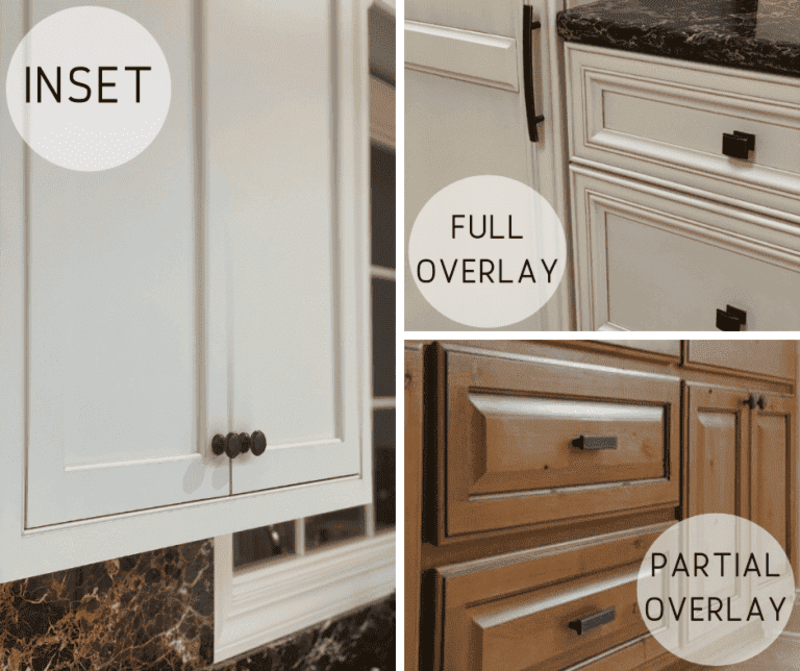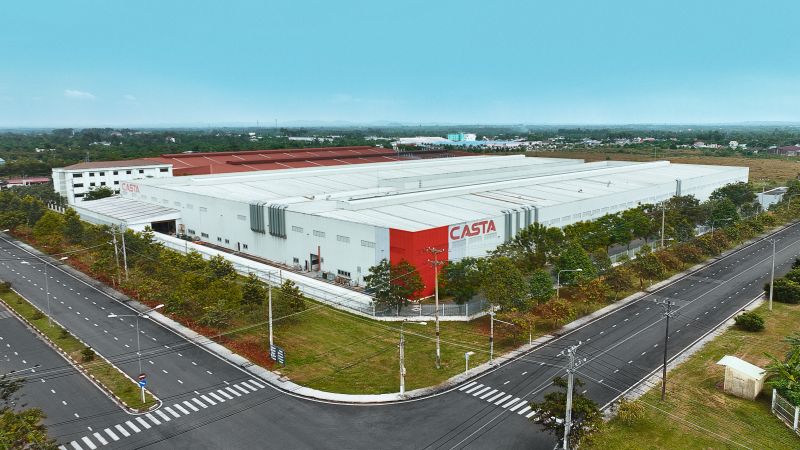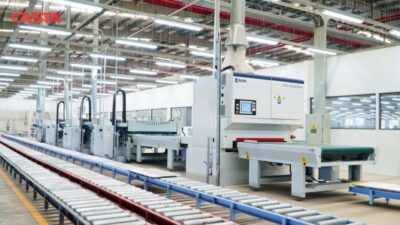When sourcing cabinetry for large-scale projects or commercial clients, understanding the distinctions between inset vs overlay cabinets is crucial. Both options offer unique benefits that can impact not only the aesthetics of a space but also the functionality and cost-efficiency of installations.
Table of Content
Inset Cabinets
Inset cabinets are distinguished by their doors and drawers that fit precisely inside the cabinet frame, creating a flush, streamlined look.
This style of cabinetry has a long history and is synonymous with high-end, traditional design.
The precision required for inset cabinets is a testament to skilled craftsmanship, which is why they are often found in luxury kitchens and homes with a focus on intricate, tailored details.

Inset cabinets are perfect for projects where the emphasis is on creating a refined and custom-built appearance, a crucial consideration for contractors working on high-end residential or bespoke commercial installations
Overlay Cabinets
In contrast, overlay cabinets are designed so that the doors and drawers sit on top of the cabinet frame, either partially or fully covering it.
This more modern approach to cabinetry allows for greater design flexibility and maximized storage space.
Overlay cabinets, especially the full-overlay variant, are popular in contemporary and minimalist kitchen designs where clean lines and efficient use of space are prioritized.

For contractors and brands, overlay cabinets offer an accessible solution that combines aesthetic appeal with functionality, catering to a wide variety of project requirements, from residential developments to commercial kitchens.
By understanding the distinctions between inset vs overlay cabinets, businesses can select the best option based on the project’s design requirements, budget constraints, and the end user's desired aesthetics. Both styles cater to different market segments, making it essential to choose the right type of cabinetry for each specific project.
Aesthetic and Functionality Differences
Visual Impact
Inset cabinets create a polished and tailored look, with doors and drawers that fit perfectly within the cabinet frame.
This classic, seamless appearance emphasizes craftsmanship, making it ideal for traditional kitchen designs, such as shaker-style or farmhouse kitchens.
The visible face frame adds a level of detail that can enhance the kitchen's overall aesthetic, offering a timeless appeal.
For contractors working on high-end residential projects or companies that specialize in custom luxury kitchens, inset cabinets are a key choice to consider.
In contrast, overlay cabinets—particularly full-overlay—create a sleek, modern appearance by covering the cabinet frame entirely.
This design minimizes visual clutter and produces a continuous, clean surface, which is well-suited for contemporary kitchens.
Partial-overlay cabinets, which allow part of the frame to remain visible, strike a balance between traditional and modern aesthetics.
Learn more: Framed vs frameless cabinets
This flexibility in design is advantageous for contractors and furniture brands looking to offer a range of options to their clients, from minimalist urban designs to transitional styles that combine old and new elements.
Functional Aspects
Functionality also plays a critical role when choosing between inset vs overlay cabinets.
Inset cabinets require a precise installation to ensure that doors and drawers align correctly within the frame. This level of precision allows for tight seams, but it also means that less storage space is available inside the cabinet compared to overlay styles.
Contractors need to account for the fact that inset cabinetry may require adjustments over time due to environmental factors such as humidity, which can cause wood to expand or contract.
Overlay cabinets, on the other hand, are more forgiving in terms of installation and maintenance.
Since the doors sit on top of the frame, they provide more interior storage space and are easier to adjust if necessary.
This makes overlay cabinets an appealing option for contractors who need to meet deadlines efficiently or for projects where ease of access and storage capacity are paramount, such as in large-scale commercial kitchens or apartment developments.
Durability and Long-Term Use
Material and Construction Durability
The durability of inset vs overlay cabinets largely depends on the materials used and the quality of construction.
Inset cabinets are known for their sturdiness due to the precise craftsmanship required for their assembly.
The tight-fitting doors and drawers minimize movement, reducing the risk of wear and tear over time. However, this precision can also make inset cabinets more susceptible to issues caused by environmental factors like temperature and humidity.
For contractors and furniture brands, maintaining these cabinets' structural integrity over time may require periodic adjustments, especially in climates prone to seasonal changes.
On the other hand, overlay cabinets offer greater flexibility in terms of material choices and construction methods.
Since the doors rest on top of the frame, they are less affected by fluctuations in humidity or temperature. This makes them an excellent choice for projects located in areas with significant environmental variation.
Overlay cabinets are also easier to maintain and adjust, which can contribute to their long-term usability in both residential and commercial settings.
Statistics on Longevity
In terms of lifespan, studies indicate that both inset vs overlay cabinets, when made from high-quality materials, offer competitive durability.
Inset cabinets can last between 20 to 30 years with regular maintenance, particularly in high-end homes where care and precision are prioritized.
Overlay cabinets, with their simpler construction and ease of maintenance, can often exceed 30 years, especially when used in environments where temperature and humidity are well-controlled.
For contractors, choosing the right cabinet type for long-term durability is crucial to ensuring customer satisfaction, especially in large-scale projects where maintenance is a key concern.
Cost Analysis
Pricing Differences
When it comes to pricing, inset cabinets are typically more expensive due to the precision required during their construction.
The meticulous craftsmanship involved in ensuring that the doors and drawers fit flush within the cabinet frame drives up both material and labor costs.
Customization options, such as intricate moldings or specialty finishes, further increase the price of inset cabinetry.
On average, inset cabinets can range from $400 to $800 per linear foot, making them a premium option for luxury projects.
In contrast, overlay cabinets are generally more affordable due to their simpler design and easier installation process.
The absence of intricate fitting requirements allows for faster production and reduced labor costs, with prices ranging from $200 to $500 per linear foot for standard overlay cabinets.
Full-overlay cabinets, while more expensive than partial-overlay options, still tend to be more budget-friendly than inset cabinets, making them an ideal choice for larger-scale projects where cost-efficiency is critical.
Factors Influencing Cost
Several factors influence the overall cost of inset vs overlay cabinets, including customization, material choice, and installation complexity.
Inset cabinets often come with a higher price tag due to the customization options available, such as decorative moldings, high-end finishes, and custom hardware.
Additionally, the type of wood or material used—whether solid wood, veneer, or laminate—can significantly impact the cost.
For projects requiring intricate designs or premium materials, the price of inset cabinetry can increase substantially.
Overlay cabinets, while generally more affordable, still vary in cost based on the level of customization and material quality.
Full-overlay cabinets, for example, offer more design flexibility and typically feature high-quality finishes, which can raise their price.
However, the overall cost remains lower than inset cabinetry due to the simpler construction and faster installation process.
Contractors and furniture brands working within tight budgets may find overlay cabinets to be the best option for maximizing value without compromising on style or functionality.
| Factor | Inset Cabinets | Overlay Cabinets |
| Cost per Linear Foot | $400 - $800 | $200 - $500 |
| Installation Costs | Higher due to precision craftsmanship | Lower due to easier installation |
| Customization Options | More intricate, traditional designs | Flexible, modern finishes available |
Customization and Design Flexibility
Customizable Elements

Inset cabinets offer a high degree of customization, allowing for detailed moldings, specialty finishes, and custom door styles.
Clients who value traditional design elements often prefer inset cabinetry because of the intricate details that can be incorporated into the doors, frames, and hardware.
The precise alignment of inset doors allows for a uniform, cohesive look that is difficult to achieve with overlay styles, making them the ideal choice for projects where craftsmanship and aesthetic detail are paramount.
Overlay cabinets, while more streamlined in appearance, also offer extensive customization options.
Full-overlay doors can be customized with various finishes, including gloss, matte, and textured surfaces, allowing for a modern or minimalist aesthetic.
Handle choices and panel configurations are also highly flexible, enabling clients to create a contemporary look that suits their project’s specific design goals.
The versatility of overlay cabinets makes them well-suited for projects where a balance of style, functionality, and budget is required.
Design Flexibility
Both inset vs overlay cabinets offer design flexibility, though the scope of customization varies.
Inset cabinets are ideal for traditional or transitional designs, where detailed craftsmanship and a refined look are essential.
The ability to add moldings, decorative elements, and high-end finishes makes inset cabinetry a popular choice for luxury homes and high-end renovations.
Overlay cabinets, on the other hand, are often preferred for modern and minimalist designs.
The clean, unbroken lines of full-overlay cabinets provide a sleek, contemporary aesthetic that works well in urban apartments, corporate offices, and commercial kitchens.
The design flexibility of overlay cabinets allows for easy adaptation to different styles and layouts, making them a practical choice for contractors and brands working on large-scale projects with diverse design requirements.
Which Customers Are Best Suited for Each Style?
Choosing between inset vs overlay cabinets largely depends on the design preferences, functional needs, and budget considerations of the client.
Both styles cater to different types of projects, and understanding the unique benefits of each helps contractors, cabinet/furniture brands, and companies make more informed recommendations for their customers.
Inset Cabinets
Ideal for High-End Residential Projects
Inset cabinets are often favored in high-end residential projects where traditional design elements and attention to detail are paramount.
Clients who value a sophisticated, tailored look will appreciate the craftsmanship involved in the production of inset cabinets.
These cabinets are perfect for homeowners seeking a timeless, classic aesthetic, especially in homes with a vintage or transitional design.
Clients Who Prioritize Precision and Customization
Clients who are willing to invest in precision craftsmanship and high-quality materials are well-suited for inset cabinetry.
The ability to customize intricate details, including moldings, finishes, and hardware, makes inset cabinets an excellent choice for homeowners who prioritize personalization.
Inset cabinetry allows for seamless integration into spaces where luxury and fine design are the focal points, such as custom-built homes or renovations aimed at increasing property value.
Projects Requiring Long-Term Durability
For projects where longevity and durability are critical, inset cabinets provide a solution that is built to last.
Although they may require occasional maintenance due to the seasonal expansion and contraction of the wood, their overall construction is highly robust.
This makes them suitable for high-end kitchens or bathrooms where clients expect premium materials and finishes that stand the test of time.
Overlay Cabinets
Best for Modern and Contemporary Projects
Overlay cabinets, particularly full-overlay styles, are ideal for projects that lean toward modern or contemporary design aesthetics.
Clients who favor sleek, minimalistic looks will find overlay cabinets to be the perfect solution.
These cabinets create a continuous, clean surface that aligns with the demands of contemporary kitchens, offices, or commercial spaces where a polished, professional appearance is essential.
Clients Seeking Cost-Effective Solutions
Overlay cabinets are often more budget-friendly than inset cabinets, making them an excellent choice for clients who want high-quality cabinetry without the premium price tag.
They are particularly suited for large-scale projects, such as multi-unit housing developments, hotel renovations, or office fit-outs, where keeping costs under control is a priority without sacrificing design flexibility.
Projects That Require Flexibility and Quick Turnaround
The ease of installation and the forgiving nature of overlay cabinets make them well-suited for projects with tight timelines or variable site conditions.
Their adaptable design also allows for quicker adjustments and less complicated maintenance over time.
Clients seeking a balance between style, functionality, and efficiency will benefit from overlay cabinets, especially in spaces where streamlined accessibility and storage optimization are crucial.
Casta - Master in Both Inset vs Overlay Cabinets
At Casta Cabinetry, we excel in delivering high-quality inset vs overlay cabinets to contractors, cabinet/furniture brands, and companies worldwide.
With a focus on precision craftsmanship, state-of-the-art manufacturing processes, and unparalleled customer support, Casta ensures that our products meet the highest standards for both aesthetic appeal and functional performance.
Inset Cabinets: The Epitome of Craftsmanship
Casta’s inset cabinets are built with exceptional attention to detail, using only premium materials and advanced machinery to ensure precision in every piece.
The doors and drawers fit seamlessly within the cabinet frame, creating a clean, refined look that is perfect for high-end residential projects.
Casta’s inset cabinets are designed to integrate effortlessly into traditional and transitional kitchen designs, delivering a sophisticated, bespoke appearance that adds value to any space.
With customization options ranging from intricate moldings to specialty finishes, Casta’s inset cabinets offer contractors and brands the ability to meet the specific design preferences of their clients.

Our commitment to quality craftsmanship ensures that each cabinet is constructed to exacting standards, providing durability and long-term reliability even in demanding environments.
Overlay Cabinets: Modern, Flexible, and Efficient
For clients seeking a modern, streamlined look, Casta’s overlay cabinets offer the perfect balance of style and functionality.
Whether it’s a full-overlay design that covers the entire frame or a partial-overlay option for a hybrid traditional-modern appearance, Casta’s overlay cabinets are crafted to suit a variety of projects, from contemporary home renovations to commercial installations.
Our use of cutting-edge European machinery guarantees that every overlay cabinet is built with precision, ensuring a flawless finish and easy installation.
The flexible design of overlay cabinets allows for efficient space utilization, making them ideal for projects that require optimized storage solutions and quick turnaround times.
With a wide range of finishes, materials, and hardware options, Casta offers unparalleled customization, allowing contractors and furniture brands to deliver tailored cabinetry solutions to their clients.
Manufacturing Excellence
Casta’s manufacturing capabilities set us apart in the cabinetry industry.
With two large-scale factories totaling over 100,000 square meters and a production capacity of 200 containers per month, we have the infrastructure to meet the demands of even the largest projects.

Our manufacturing process is 90% automated, ensuring precision, consistency, and efficiency in every cabinet we produce.
At Casta, we prioritize sustainability and quality, holding certifications such as CARB, FSC, and adherence to the European E1 Emission Standard.
These credentials underscore our commitment to environmental responsibility and excellence in craftsmanship, making us a trusted partner for businesses that require not only top-tier cabinetry but also eco-friendly solutions.
Conclusion: Choosing the Best Option
Choosing between inset vs overlay cabinets depends on the specific needs of the project and the client’s design goals.
Inset cabinets offer timeless elegance and precision craftsmanship, making them ideal for traditional and high-end projects where attention to detail is key.
Overlay cabinets, on the other hand, provide a modern, streamlined look with greater flexibility and ease of installation, making them a cost-effective solution for contemporary designs and large-scale projects.
For contractors, cabinet/furniture brands, and companies, the decision comes down to understanding the client’s vision, budget, and functional requirements.
With Casta Cabinetry’s expertise in both inset vs overlay cabinets, you can confidently deliver high-quality, customized solutions that meet the unique needs of your projects.
FAQ
What is the key difference between inset vs overlay cabinets for commercial projects?
Which type of cabinet is more budget-friendly for large-scale installations?
Why choose Casta Cabinetry for inset or overlay cabinets?

Best Private Label Furniture Manufacturer for US Brands...
In today’s competitive market, working with the right private label furniture manufacturer is crucial for brands aiming ...
07/17/2025 | David Nguyen

Cabinet Manufacturing Process: From Raw Material to Custom D...
Today’s North American contractors, furniture brands, and developers demand more from cabinet manufacturers: speed, accu...
07/15/2025 | David Nguyen

Automated Cabinet Manufacturing: Benefits for North American...
Cabinet manufacturing has evolved dramatically in the last decade. As demand for scalable, high-quality production incre...
07/13/2025 | David Nguyen

How to Buy Kitchen Cabinets from Vietnam
Whether you’re a contractor, cabinet brand, or procurement manager, learning how to buy kitchen cabinets can make ...
07/11/2025 | David Nguyen
Contact us
Casta is always ready to listen and answer all customers' questions













